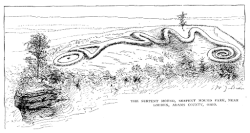
Back عصر الغابات Arabic Лясны перыяд у Паўночнай Амерыцы Byelorussian Període Silvícola Catalan Woodland-Periode German Cronología de las culturas constructoras de montículos en Norteamérica Spanish Pohjois-Amerikan itäinen metsämaan kausi Finnish Période sylvicole French Periodo Woodland Italian Woodland-periode Dutch Вудлендский период Russian
| Periods in North American prehistory |
|---|
 |
In the classification of archaeological cultures of North America, the Woodland period of North American pre-Columbian cultures spanned a period from roughly 1000 BCE to European contact in the eastern part of North America, with some archaeologists distinguishing the Mississippian period, from 1000 CE to European contact as a separate period.[1] The term "Woodland Period" was introduced in the 1930s as a generic term for prehistoric sites falling between the Archaic hunter-gatherers and the agriculturalist Mississippian cultures. The Eastern Woodlands cultural region covers what is now eastern Canada south of the Subarctic region, the Eastern United States, along to the Gulf of Mexico.[2]
This period is variously considered a developmental stage, a time period, a suite of technological adaptations or "traits", and a "family tree" of cultures related to earlier Archaic cultures.[3] It can be characterized as a chronological and cultural manifestation without any massive changes in a short time but instead having a continuous development in stone and bone tools, leather crafting, textile manufacture, cultivation, and shelter construction. Many Woodland peoples used spears and atlatls until the end of the period, when they were replaced by bows and arrows; however, Southeastern Woodland peoples also used blowguns.
The most cited technological distinction of this period was the widespread use of pottery (although pottery manufacture had arisen during the Archaic period in some places), and the diversification of pottery forms, decorations, and manufacturing practices. The increasing use of horticulture and the development of the Eastern Agricultural Complex, consisting of weedy seed plants as well as gourd cultivation, also meant that groups became less mobile over time and, in some times and places, people lived in permanently occupied villages and cities. Intensive agriculture characterizes the Mississippian period from c. 1000–1400 CE and may have continued up to European contact, around 500 years ago.[4]
- ^ McDonald and Woodward, Indian Mounds of the Atlantic Coast: A Guide from Maine to Florida, McDonald & Woodward Publishing Company, Newark OH, 1987 p.13
- ^ "Eastern Woodland Indians Culture". Native Art in Canada. Retrieved 2011-06-03.
- ^ Mason, Ronald J. (1970). "Hopewell, Middle Woodland, and the Laurel Culture: A Problem in Archaeological Classification". American Anthropologist 72(4):802–15.
- ^ Neusius, Sarah W. and G. Timothy Gross (2014). "Seeking Our Past: An Introduction to North American Archaeology". Oxford University Press.
© MMXXIII Rich X Search. We shall prevail. All rights reserved. Rich X Search